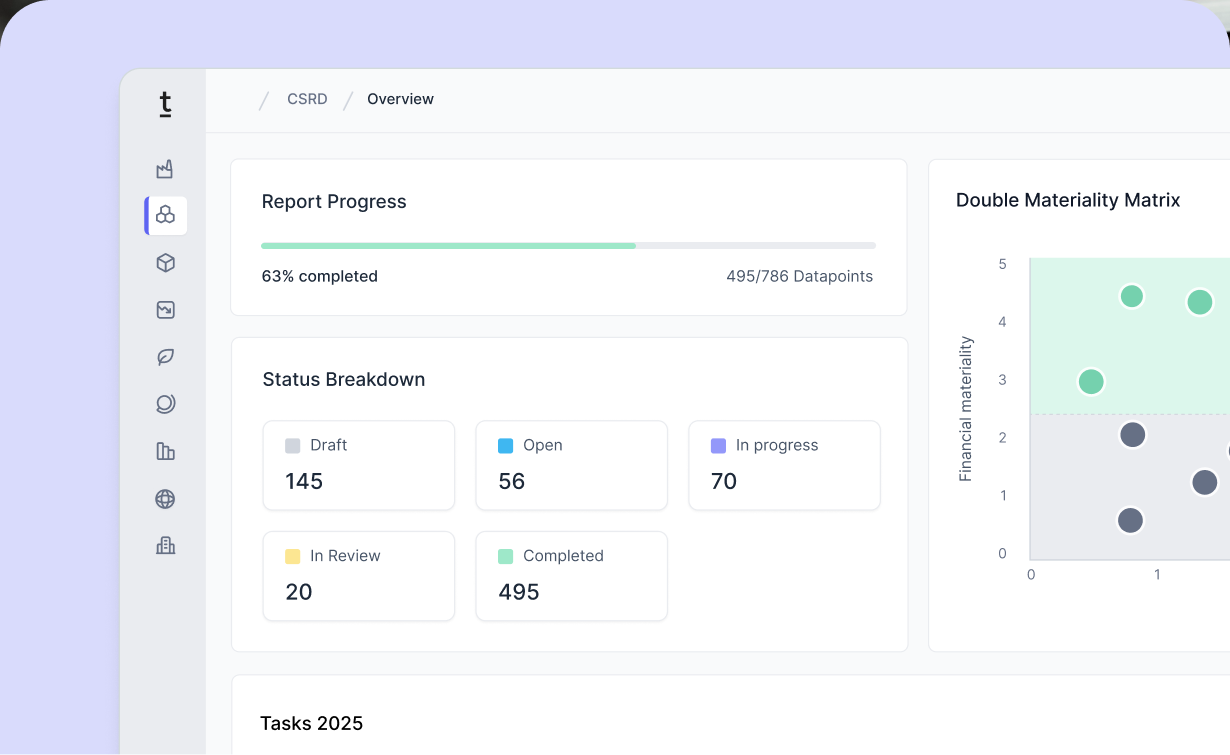Double Materiality Assessment | ESRS examples of impacts, risks and opportunities

The European Sustainability Reporting Standards (ESRS) are a pioneering development in the field of non-financial reporting and a key standard of the Corporate Sustainability Reporting Directive (CSRD). Companies must provide relevant, comparable and reliable information about their sustainability-related impacts, risks and opportunities. The ESRS contain detailed and standardized disclosure requirements to enable companies to report on environmental, social and economic (ESG) issues.
Double materiality assessment
Before reporting on sustainability aspects, the CSRD requires companies to carry out a double materiality assessment. This assessment requires companies to identify and evaluate their positive and negative impacts on the environment and society by including both potential and actual effects. External influences that could affect financial performance must also be taken into account. This approach promotes a comprehensive and open assessment of a company's sustainability performance. The criteria for the double materiality assessment are defined in the European Sustainability Reporting Standards ESRS 1 and the results must be reported in accordance with ESRS 2.
Double materiality: identifying and mitigating relevant risks between companies and the climate

ESRS requirements
The ESRS represent an overarching framework for all affected company types and sizes. It consists of two cross-cutting standards (ESRS 1 and ESRS 2) and 10 topic-specific standards covering environmental, social and governance (ESG) topics.
While ESRS 1 ("General Requirements") sets out general rules for reporting in accordance with ESRS, but without making specific disclosures, ESRS 2 ("General Disclosures") describes basic information that must be published regardless of the sustainability issue under consideration and is mandatory for all companies that fall under the scope of the CSRD.
The other standards and the individual disclosure requirements and data points depend on the result of the double materiality assessment, whereby both the inside-out perspective (impact materiality) and the outside-in perspective (financial materiality) must be taken into account. These two perspectives are fundamental for identifying the strategically relevant sustainability topics and the associated reporting requirements, with ESRS E1 and ESRS S1 generally forming the basis for industrial companies.

Examples of impact materiality and financial materiality
As part of the double materiality assessment, it is necessary to carry out a comprehensive assessment that not only covers the ten topic-specific standards, but also takes additional topics into account. These are divided into overarching topics, sub-topics and further sub-sub-topics. A complete list of these topics can be found here.
In this process, companies must identify their material impacts, risks and opportunities of these 91 topics. Material impacts include both positive and negative effects of business activities on the environment and stakeholders (impact materiality), while material risks and opportunities include the financial aspects resulting from dependence on resources such as natural, human and social factors (financial materiality) Enclosed you will find an example of each of ESRS E1, ESRS S1 and ESRS G1.
Enclosed you will find an example of ESRS E1, ESRS S1 and ESRS G1.
ESRS E1 - Climate change

ESRS S1 - Own workforce

ESRS G1 - Governance

How Tanso can support you with the Double Materiality Assessment
After successfully completing the double materiality assessment, Tanso software enables companies to meet CSRD requirements and achieve sustainability goals through audit-compliant and integrated ESRS reporting to the highest standards. Our focus on data-intensive categories (e.g. corporate carbon footprint) enables Tanso not only to report in accordance with standards, but also to actively engage in the management and optimization of ESG performance. Learn more here.


















































.avif)







.jpg)
.jpg)




















-p-800.webp.avif)
-min-p-800.webp.avif)






-p-800.webp.avif)

